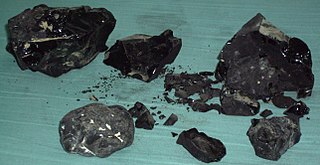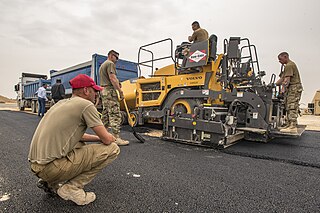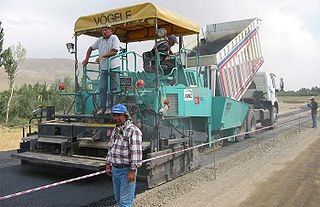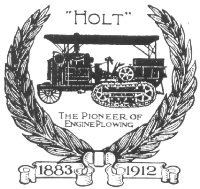
Bitumen is an immensely viscous constituent of petroleum. Depending on its exact composition it can be a sticky, black liquid or an apparently solid mass that behaves as a liquid over very large time scales. In American English, the material is commonly referred to as asphalt. Whether found in natural deposits or refined from petroleum, the substance is classed as a pitch. Prior to the 20th century, the term asphaltum was in general use. The word derives from the Ancient Greek word ἄσφαλτος (ásphaltos), which referred to natural bitumen or pitch. The largest natural deposit of bitumen in the world is the Pitch Lake of southwest Trinidad, which is estimated to contain 10 million tons.

A road surface or pavement is the durable surface material laid down on an area intended to sustain vehicular or foot traffic, such as a road or walkway. In the past, gravel road surfaces, macadam, hoggin, cobblestone and granite setts were extensively used, but these have mostly been replaced by asphalt or concrete laid on a compacted base course. Asphalt mixtures have been used in pavement construction since the beginning of the 20th century and are of two types: metalled (hard-surfaced) and unmetalled roads. Metalled roadways are made to sustain vehicular load and so are usually made on frequently used roads. Unmetalled roads, also known as gravel roads or dirt roads, are rough and can sustain less weight. Road surfaces are frequently marked to guide traffic.

Asphalt concrete is a composite material commonly used to surface roads, parking lots, airports, and the core of embankment dams. Asphalt mixtures have been used in pavement construction since the beginning of the twentieth century. It consists of mineral aggregate bound together with bitumen, laid in layers, and compacted.

The free floating screed is a device pioneered in the 1930s that revolutionized the asphalt paving process. The device is designed to spread and smooth out, or screed, the material below it.

Heavy equipment, heavy machinery, earthmovers, construction vehicles, or construction equipment, refers to heavy-duty vehicles specially designed to execute construction tasks, most frequently involving earthwork operations or other large construction tasks. Heavy equipment usually comprises five equipment systems: the implement, traction, structure, power train, and control/information.

In civil engineering, a wheel tractor-scraper is a type of heavy equipment used for earthmoving. It has a pan/hopper for loading and carrying material. The pan has a tapered horizontal front cutting edge that cuts into the soil like a carpenter's plane or cheese slicer and fills the hopper which has a movable ejection system. The horsepower of the machine, depth of the cut, type of material, and slope of the cut area affect how quickly the pan is filled.

A paver is a piece of construction equipment used to lay asphalt concrete or Portland cement concrete on roads, bridges, parking lots and other such places. It lays the material flat and provides minor compaction. This is typically followed by final compaction by a road roller.

A heavy equipment operator operates heavy equipment used in engineering and construction projects. Typically only skilled workers may operate heavy equipment, and there is specialized training for learning to use heavy equipment.

A pugmill, pug mill, or commonly just pug, is a machine in which clay or other materials are extruded in a plastic state or a similar machine for the trituration of ore. Industrial applications are found in pottery, bricks, cement and some parts of the concrete and asphalt mixing processes. A pugmill may be a fast continuous mixer. A continuous pugmill can achieve a thoroughly mixed, homogeneous mixture in a few seconds, and the right machines can be matched to the right application by taking into account the factors of agitation, drive assembly, inlet, discharge, cost and maintenance. Mixing materials at optimum moisture content requires the forced mixing action of the pugmill paddles, while soupy materials might be mixed in a drum mixer. A typical pugmill consists of a horizontal boxlike chamber with a top inlet and a bottom discharge at the other end, 2 shafts with opposing paddles, and a drive assembly. Some of the factors affecting mixing and residence time are the number and the size of the paddles, paddle swing arc, overlap of left and right swing arc, size of mixing chamber, length of pugmill floor, and material being mixed.

Hyster is an American manufacturing company specializing in forklifts and other materials-handling equipment. Hyster was founded in 1929 as the Willamette-Ersted Company in Portland, Oregon. The company was purchased in 1989 by NACCO Industries, Inc. and became a part of NACCO Materials Handling Group. NACCO spun off the materials handling business in 2012 as Hyster-Yale Materials Handling, Inc., which continues to market products under the Hyster brand name.

A screw conveyor or auger conveyor is a mechanism that uses a rotating helical screw blade, called a "flighting", usually within a tube, to move liquid or granular materials. They are used in many bulk handling industries. Screw conveyors in modern industry are often used horizontally or at a slight incline as an efficient way to move semi-solid materials, including food waste, wood chips, aggregates, cereal grains, animal feed, boiler ash, meat, bone meal, municipal solid waste, and many others. The first type of screw conveyor was the Archimedes' screw, used since ancient times to pump irrigation water.

Blaw-Knox is a manufacturer of road paving equipment. The company was created in 1917 from the merger of Blaw Collapsible Steel Centering Company and the Knox Pressed and Welded Steel Company. Blaw-Knox was sold to new owners in 1968, changed owners a few times thereafter, and continues as the Volvo Blaw-Knox brand of paving equipment, sold to Volvo Construction Equipment since 2007. Since July 2020 it is owned by Gencor Industries Inc.

Superior Industries, Inc. is an American manufacturing company headquartered in Morris, Minnesota. The company engineers, manufactures, sells and supports dry bulk processing and handling equipment and components. In 2008, Superior acquired Westmor Industries, a manufacturer and distributor of energy storage, transportation and dispensing equipment also headquartered in Morris.

The Holt Manufacturing Company began with the 1883 founding of Stockton Wheel Service in Stockton, California, United States. Benjamin Holt, later credited with patenting the first workable crawler ("caterpillar") tractor design, incorporated the Holt Manufacturing Company in 1892. Holt Manufacturing Company was the first company to successfully manufacture a continuous track tractor By the early 20th century, Holt Manufacturing Company was the leading manufacturer of combine harvesters in the US, and the leading California-based manufacturer of steam traction engines.

Stedman Machine Company is a manufacturer of crushing equipment in Aurora, Indiana, United States, that was founded by Nathan Rockwell Stedman in 1834.

The Municipal Asphalt Plant is a former asphalt plant at York Avenue and 91st Street on the Upper East Side of Manhattan in New York City, housing the Asphalt Green recreation center. The asphalt plant was completed in 1944 to designs by Ely Jacques Kahn and Robert Allan Jacobs. The current structure, originally a mixing plant, reopened as the George and Annette Murphy Center in 1984. The asphalt plant, which formerly included a conveyor belt and storage facility, produced asphalt that was used to pave roads in Manhattan. The Murphy Center is a New York City designated landmark and is listed on the National Register of Historic Places.
Soil stabilizers and road recyclers are engineering vehicles that were once similar machines; however, they are now specialised pieces of road making machinery and have developed into different machines. Other terms that are sometimes used are: road profiler, road reclaimer, road miller, road planer and pavement profiler. They are used in the process of full depth recycling.

Bitelli was an engineering company located in Bologna, Italy - the largest and, perhaps best known, Italian construction machinery firm. Beppino Bitelli produced his first three wheel roller in 1933 although it was not until 1957 that the Bitelli Road Mechanics company was formed. Tandem rollers were soon added and In 1969 the first single drum rollers were manufactured. In 1978 Bitelli built its first paving machine and, during the 1980s, road profilers and soil stabilizers were added to the line of road machines.
CMI Roadbuilding, Inc. of Oklahoma City began in 1961, when engineers headed by Bill Swisher started looking for new methods in the road building industry. Little had changed since the early 1900s in the methods of building roads, however, labor costs were skyrocketing and inflation meant taxpayers dollars were buying less and less. In the same period Society was becoming increasingly more mobile creating demand for better roads and highways. The CMI group believed that many road failures were due to poor riding surface which was mainly caused by inaccuracies in the subgrade.
Wirtgen Group is an internationally operating German company in the construction industry. The company's core business is the development and production of machinery for road construction and maintenance.




















